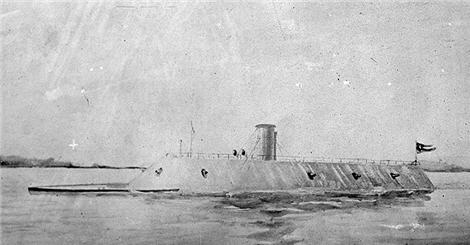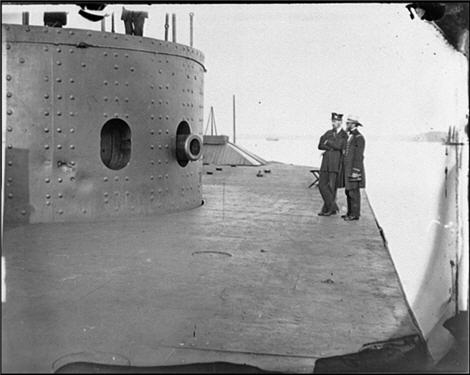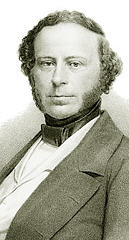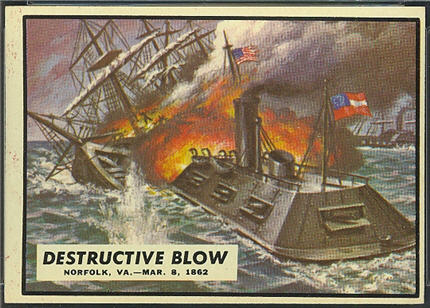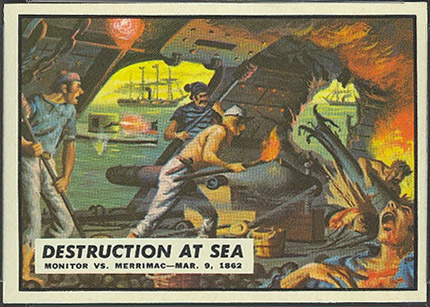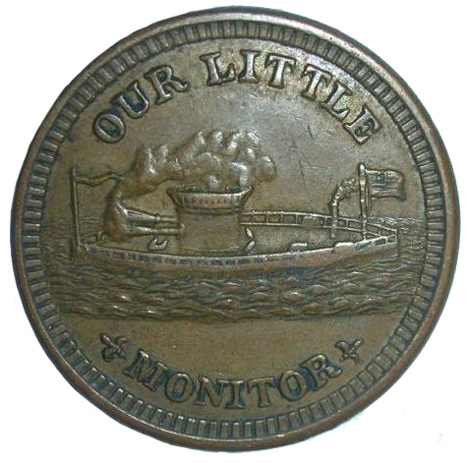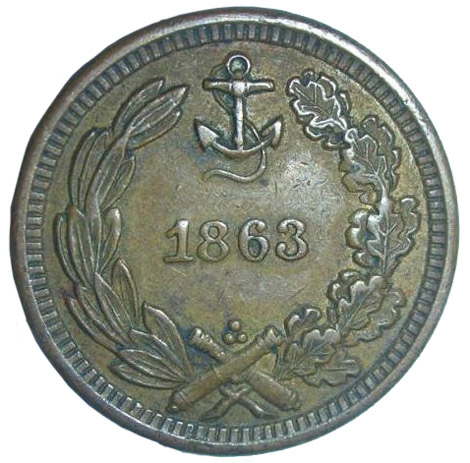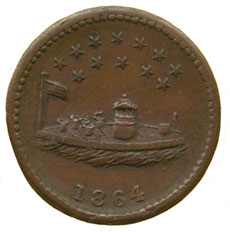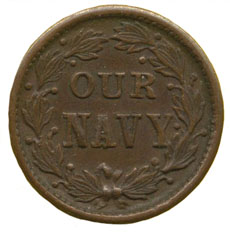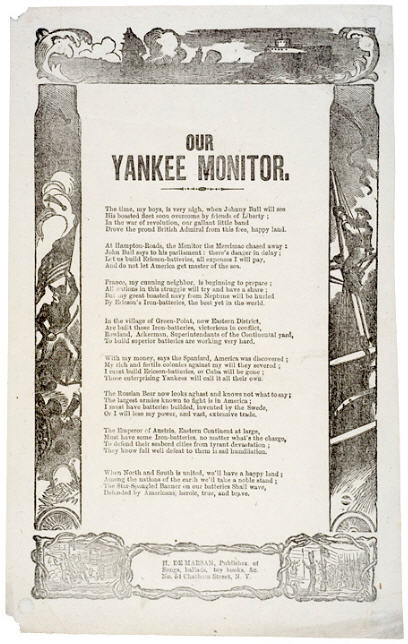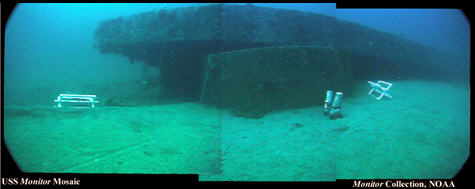
 |
 |
|
| |
||


Monitor vs. MerrimacThe showdown between the USS Monitor and the CSS Virginia (more commonly called the Merrimac) took place on the James River at the Battle of Hampton Roads. It was arguably a turning point for naval warfare, ending the era of wooden military vessels.
The Merrimac (a.k.a. USS Merrimack, CSS Virginia)The Merrimack (the vessel was christened with a K in its name, which was eventually dropped) was completed in February 1856. At 256 feet long, it was one of the largest vessels in the U.S. Navy. The Merrimac cruised the West Indies, but was taken out of active duty with barely a year of service, on April 22, 1857. Shortly thereafter, she was recommissioned as the flagship of the Pacific squadron. After serving two and a half years in the Pacific, the Merrimac was sent to the Gosport Navy Yard for repairs, which were never made. (Gosport was the original name for the Norfolk Naval Shipyard in Portsmouth, Virginia.) Secretary of the Navy Gideon Welles wanted the Merrimac in condition to move to Philadelphia, and wired that instruction to the Superintendent of the Gosport Yard, Commodore Chas S. McCauley, on April 11, 1862. It wasn't to be. Because the Union did not want to act aggressively lest Virginia secede, and because of sessionist sympathies at Norfolk, the Merrimac was not readied before the Confederates threatened the ship yard. On April 19, the Confederates made it appear that their troops were already in Norfolk. So Commodore McCauley ordered all the guns and vessels at the Gosport docks destroyed. Ammunition was thrown overboard and the Merrimac was sunk. The Confederates, however, salvaged much of the drydock and machinery, and recovered 4000 shells, 2000 barrels of powder, and 1000 loose guns. And the Merrimac? Though burned and sunk, the Confederates also recovered the Merrimac. Using the hull and engines from the former US frigate USS Merrimack as a foundation, Confederate builders made the CSS Virginia at the Norfolk Navy Yard in Virginia. Stephen Russell Mallory, Secretary of the Navy for the Confederate States of America, suggested making ironclads that "were already being turned out in limited numbers by the British and the French." Mallory reported that to restore the Merrimac to her original condition would require at least $450,000--the original cost was $700,000--but to make her an ironclad would require just $172,523. Thus, the USS Merrimack became the CSS Virginia, designed by John Brooke. She was plated with about 1,000 tons of iron. Four inches thick, the iron plates were bolted on a 24-inch wooden wall. Since ammunition was scarce, the CSS Virginia was equipped with a formiddable ram.
Even after the Merrimac became the CSS Virginia, Union men and sympathisers--almost without exception--called the vessel the "Merrimack" in reports and other correspondence during the Civil War.
The Monitor (a.k.a. USS Monitor)The USS Monitor was named by her inventor, John Ericsson. Born in 1803, Ericsson served as a cadet in a corps of naval mechanical engineers and as an ensign in the Swedish Army. He went to London in 1826. Coming to the United States in 1839, to help build its first screw-propelled warship, he became deeply absorbed in his work. Seeming to now be a second-mate, his wife went home to England and never returned. But Ericsson was regarded as a controversial figure by the U.S. Navy because of tragedy with a vessel with which Ericsson was affiliated (though he was really just a scapegoat for the incident). Hence, his participation in the construction of a maritime vessel for the Civil War was not a smooth venture. Two months after the CSA had resurrected the Merrimac, an extra session of the U.S. Congress convened. On July 4, 1861, at Lincoln's recommendation, a report was submitted that noted the Confederacy was constructing an armored vessel. Another month passed before Congress authorized the creation of an "Ironclad Board of three skilful naval officers" to decide on new warships and appropriated $1.5 million for armored vessels. In August, Secretary of the Navy Gideon Wells advertised for proposals related to the construction of "One or more ironclad steam vessels of war...for either sea or river service to be no less than ten or sixteen feet draught of water...." John Ericsson submitted his proposal for what would become the USS Monitor. (Ericsson had actually made a model of the Monitor in 1854, presenting it to Napoleon III. However, Ericsson later told his biographer, William Conant Church, that the French made no use of it.) The proposal was routed through Cornelius Bushnell--who had been awarded a contract for an ironclad that he feared would not work--and was presented to President Abraham Lincoln at the White House on September 12, 1861. The "cheesebox on a raft" design by Ericsson intrigued Lincoln so he accompanied Bushnell to the Navy Department. Bushnell and Lincoln met the next day with the Ironclad Board, whose members listened to the presentation with anxiety. There was a lot of negative energy in the room and muffled objections abounded, but Abraham Lincoln backed the design, saying, "All I have to say is what the girl said when she stuck her foot in the stocking. 'It strikes me there's something in it.'"
 You can build your own Monitor model with this kit available on Amazon
Construction of the Monitor authorized by the United States Navy in October 1861, with the stipulation of a "money-back guarantee" in the event of a failure in Ericsson's design. She was built at Green Point in Brooklyn, New York.
The Monitor was an iron-plated flat-topped boat, pointed on both ends and just 172 feet long. She was 41 feet at her greatest width. The deck was a mere 18 inches above the water line. On the middle of the deck was a round flat-topped turret sheathed in 8-inch iron plating. Commonly called "the cheesebox," the turret rose several feet above the deck, holding the only guns on the boat: twin Dahlgren 11-inch guns "as large as any in either the Union or Confederate Navy." The idea of a turret or revolving gun emplacement was not new, but Erricson was the first to make use of it in a war device.
Destruction at SeaLieutenant John L. Worden had been a sailor for 27 years, including a 7-month period of captivity as a Confederate prisoner. After his release, Lt. Worden (then 43 years old) was put in command of the Monitor in January 1862. On January 30, 1862, the USS Monitor was launched. Her first action in battle would be against the Merrimac. Three months later, the commander of the Confederate squadron on the James River, Capt. Frank Buchanan, boarded the CSS Virginia (a.k.a. the Merrimac) to head toward Newport News. On March 8, 1862, a battle raged off the coast of Norfolk, Virginia. The Merrimac engaged the USS Cumberland. The Cumberland fired on the Merrimac's 4-inch armor, but the shots simply glanced off. The Merrimac then rammed the USS Cumberland, tearing a large hole under her waterline. Within 15 minutes, the Cumberland sank to the bottom of the river. The era of wood was over; the erra of iron had come. The Merrimac then turned to the USS Congress and pelted her with shells. The men of the Congress surrendered. As Union ships Minnesota, St. Lawrence, and Roanoake tried to reach the Merrimac, they ran aground in the receding waters. The river evenually got too shallow even for the Merrimac, so the battle stopped for the evening.
The next day, Lt. Catesby Jones took over for Capt. Buchanan (who had been wounded the day before) and headed for the USS Minnesota, who was still marooned from the prior evening. But before the Merrimac could reach the Minnesota, Lt. Worden and the Monitor raced toward the action. She could operate in just half the depth of water required by the Merrimac and had greater speed than her opponent. Having just arrived from New York hours before, she intercepted and fired on the Merrimac. On the shore at Hampton Roads, thousands of sailors and soldiers from both sides, joined civilians and lined the shores to watch the action. The Battle of Hampton Roads was underway. In an era when the number of guns implied the strength of the vessel, the Monitor's two guns seemed no match for the Merrimac's ten. In fact, the Monitor had a real disadvantage in that her pilot house was in the way of the revolving turret and could actually come under her own fire. Still, guns blazed. But the protective iron plating on both vessels did its job. One gunner on the Merrimac quit firing at one point saying, "It is quite a waste of ammunition to fire at her. Our powder is precious, sir, and I find I can do the Monitor as much damage by snapping my finger at her every five minutes." The Merrimac hit the Monitor 23 times in four hours to no avail. The Monitor, hitting the Merrimac 20 times in the same period, was unsuccessful as well. (Both vessels were protected on top by iron plating, but below the water line, each had a wooden hull. Neither vessel hit the other below the water line, where both vessels were vulnerable.) The Merrimac even tried ramming the Monitor, but because her ram was damaged in her battle with the USS Cumberland the day before--and because Jones didn't go as fast, fearing getting stuck again as happened with the Cumberland--the Merrimac simply glanced off the sides of the Monitor without inflicting any damage. Even the Monitor tried ramming the Merrimac. Worden ordered her turned around and aimed at the Merrimac's stern. At full speed they were on target when suddenly the Monitor's steering apparatus malfunctioned and she missed the Merrimac by a few feet. Jones was convinced that he could not injure the Monitor, so his officers suggested attempting to board the Monitor with wedges and hammers, with the goal of freezing the revolving gun turret in place. It sounded like a good idea, but Jones didn't approve it--which was fortunate, because the Monitor's crew had already anticipated such action. They were at the ready with hand grenades which could be tossed out onto the deck from the turret. The Monitor crew would be protected by the turret, but the Confederates would have no where to go to escape the explosions except by jumping in the water. Though the battle was a draw, both sides claimed a victory, charging that the other had withdrawn in defeat. The Monitor had drifted away when Commodore S.D. Greene, as second in command, left his post to aid Worden, who had been injured and temporarily blinded. The Merrimac could not follow the Monitor into those shallow waters, so thinking the Monitor was retreating, she withdrew toward Sewell's Point. Seeing this, Greene thought the Merrimac was retreating.
There was no rematch. Just two months later, the Merrimac was destroyed by her own crew. The Union blockade remained unbroken so the Norfolk ship yard was of little strategic use to the Confederacy. Norfolk was abandoned by the CSA Army so Commodore Tatnall, now in charge of the Merrimac, had his men destroy the vessel lest the Union capture it. The Monitor didn't survive to see the new year either. On the night of December 31, 1862, the Monitor sank off the coast of Cape Hatteras, North Carolina. She was being towed down the coast to take part in the Union blockade, but strong winds swamped the vessel and the water put out the fire in her engines. The order was given to abandon ship, but 16 men perished with the great ironclad monitor.
"Our Little Monitor" Civil War TokensThe USS Monitor was one of the most successful ship prototypes in history. The name "Monitor" eventually became the generic term for light craft, coast defense ironclads. Sixty more monitors were built in a variety of classes, most with double turrets. Subsequent monitors had one important improvement over the USS Monitor: The pilot house was placed upon the turret in later monitor vessels. The Monitor was memorialized on a Civil War token in 1863. Tokens of this type were issued by private parties in lieu of scarce coinage and currency, which had been horded during war time. Fuld die numbers 237 through 241 depict monitor vessels. The token shown here is 19mm in diameter. The obverse shows a monitor with her two guns blazing, with "OUR LITTLE MONITOR" inscribed around the vessel. An anchor and crossed cannons is on the reverse. The "Our Little Monitor" Civil War tokens are easy to find on eBay and generally sell for between $50 and $60, depending on condition, of course. eBay auctions ending on March 4, March 19, and March 20, 2010, sold for $56, $58 and $52, respectively.
Other Civil War tokens depict a monitor without naming the vessel on the front. A field of 12 stars is above the monitor and the inscribed year is 1864. The reverse shows a wreath around the inscription, "OUR NAVY."
"Monitor" Civil War SongsheetsSongsheets printed during the Civil War and shortly thereafter commemorated important people and events of the war. Our Yankee Monitor was published by H. De Marsan of New York. The lyrics to the eight-verse song are surrounded by a border of military vignettes. The song refers to European powers--including Britain, France, Spain, Russia, and Austria--fearing the loss of naval dominance after the Civil War. This is Spain's expression of this plight:
An "Our Yankee Monitor" songsheet in near-pristine condition sold on iCollector in October 2009, for $170. The same description and picture is featured in an eBay
Recovery of the USS Monitor WreckFour score and two years later, in 1945, the U.S. Navy detected what it thought might be the USS Monitor while it was testing the Underwater Object Locator (UOL) Mark IV. But current and conditions prevented the Navy from confirming the discovery. The Navy formally abandoned the wreck of the USS Monitor on September 30, 1953, surrendering all claims to the vessel. In August 1973, the USS Monitor was found 16 miles south-southeast of Cape Hatteras, NC, in 240 feet of water. The Monitor became the first national marine sanctuary in 1975. She is listed on the National Register and is a designated a National Landmark in recognition of her historic significance. The National Marine Sanctuary program oversees the Monitor site. In 2002, the turret from the Monitor was recovered from the Atlantic Ocean, along with several other artifacts. The entire vessel is unlikely to ever be raised because of its condition. Current technologies are insufficient for raising the wreck without destroying the remainder of the vessel.
Don't make this mistake: It's OK to prefer the purist spelling of "Merrimack," but it's a misspelling to refer to the Merrimac as "Marrimac." Author of this article: Renee Gentry sources: Davis, William C. Duel Between the First Ironclads, Marvel, William (ed.). The Monitor Chronicles: One Sailor's Account, New York: Simon and Schuster, 2000. The Monitor: Its Meaning and Future, Papers from a National Conference, Raleigh, NC, April 2-4, 1978. Washington, D.C.: The Preservation Press, 1978 (ISBN 0-89133-071-2), pp. 19, 42, 72-74. Thulesius, Olav. "USS Monitor: A Cheesebox on a Raft," America's Civil War magazine, November 2006. Trexler, Harrison A. The Confederate Ironclad "Virginia" ("Merrimac"), Chicago: University of Chicago Press, 1938, pp. 1-4, 11-13, 28-29, 35-43, 249.
|
 |
Copyright © 2005-2015 Alta Omnimedia. All Rights Reserved.



